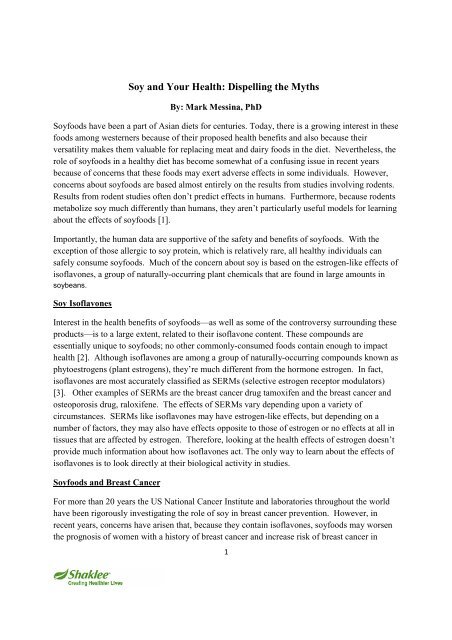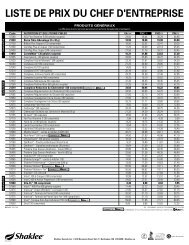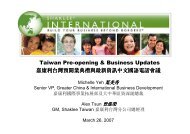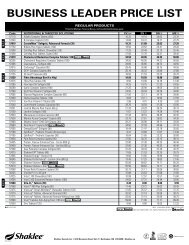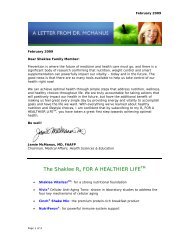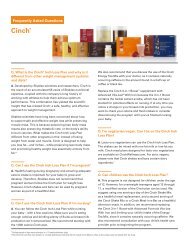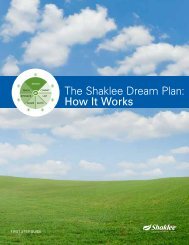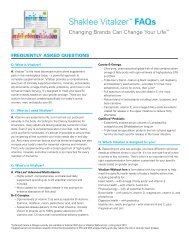Soy and Your Health: Dispelling the Myths - Shaklee
Soy and Your Health: Dispelling the Myths - Shaklee
Soy and Your Health: Dispelling the Myths - Shaklee
Create successful ePaper yourself
Turn your PDF publications into a flip-book with our unique Google optimized e-Paper software.
<strong>Soy</strong> <strong>and</strong> <strong>Your</strong> <strong>Health</strong>: <strong>Dispelling</strong> <strong>the</strong> <strong>Myths</strong><br />
By: Mark Messina, PhD<br />
<strong>Soy</strong>foods have been a part of Asian diets for centuries. Today, <strong>the</strong>re is a growing interest in <strong>the</strong>se<br />
foods among westerners because of <strong>the</strong>ir proposed health benefits <strong>and</strong> also because <strong>the</strong>ir<br />
versatility makes <strong>the</strong>m valuable for replacing meat <strong>and</strong> dairy foods in <strong>the</strong> diet. Never<strong>the</strong>less, <strong>the</strong><br />
role of soyfoods in a healthy diet has become somewhat of a confusing issue in recent years<br />
because of concerns that <strong>the</strong>se foods may exert adverse effects in some individuals. However,<br />
concerns about soyfoods are based almost entirely on <strong>the</strong> results from studies involving rodents.<br />
Results from rodent studies often don’t predict effects in humans. Fur<strong>the</strong>rmore, because rodents<br />
metabolize soy much differently than humans, <strong>the</strong>y aren’t particularly useful models for learning<br />
about <strong>the</strong> effects of soyfoods [1].<br />
Importantly, <strong>the</strong> human data are supportive of <strong>the</strong> safety <strong>and</strong> benefits of soyfoods. With <strong>the</strong><br />
exception of those allergic to soy protein, which is relatively rare, all healthy individuals can<br />
safely consume soyfoods. Much of <strong>the</strong> concern about soy is based on <strong>the</strong> estrogen-like effects of<br />
isoflavones, a group of naturally-occurring plant chemicals that are found in large amounts in<br />
soybeans.<br />
<strong>Soy</strong> Isoflavones<br />
Interest in <strong>the</strong> health benefits of soyfoods—as well as some of <strong>the</strong> controversy surrounding <strong>the</strong>se<br />
products—is to a large extent, related to <strong>the</strong>ir isoflavone content. These compounds are<br />
essentially unique to soyfoods; no o<strong>the</strong>r commonly-consumed foods contain enough to impact<br />
health [2]. Although isoflavones are among a group of naturally-occurring compounds known as<br />
phytoestrogens (plant estrogens), <strong>the</strong>y’re much different from <strong>the</strong> hormone estrogen. In fact,<br />
isoflavones are most accurately classified as SERMs (selective estrogen receptor modulators)<br />
[3]. O<strong>the</strong>r examples of SERMs are <strong>the</strong> breast cancer drug tamoxifen <strong>and</strong> <strong>the</strong> breast cancer <strong>and</strong><br />
osteoporosis drug, raloxifene. The effects of SERMs vary depending upon a variety of<br />
circumstances. SERMs like isoflavones may have estrogen-like effects, but depending on a<br />
number of factors, <strong>the</strong>y may also have effects opposite to those of estrogen or no effects at all in<br />
tissues that are affected by estrogen. Therefore, looking at <strong>the</strong> health effects of estrogen doesn’t<br />
provide much information about how isoflavones act. The only way to learn about <strong>the</strong> effects of<br />
isoflavones is to look directly at <strong>the</strong>ir biological activity in studies.<br />
<strong>Soy</strong>foods <strong>and</strong> Breast Cancer<br />
For more than 20 years <strong>the</strong> US National Cancer Institute <strong>and</strong> laboratories throughout <strong>the</strong> world<br />
have been rigorously investigating <strong>the</strong> role of soy in breast cancer prevention. However, in<br />
recent years, concerns have arisen that, because <strong>the</strong>y contain isoflavones, soyfoods may worsen<br />
<strong>the</strong> prognosis of women with a history of breast cancer <strong>and</strong> increase risk of breast cancer in<br />
1
women at high risk of developing this disease. These concerns are based on research in one<br />
particular type of mouse [4].<br />
In contrast to <strong>the</strong> animal research, human research is supportive not only of safety but also of<br />
potential benefit. For example, in clinical studies, when female subjects are given ei<strong>the</strong>r<br />
soyfoods or <strong>the</strong> isoflavones from soyfoods, <strong>the</strong>re is no effect on indicators of breast cancer risk,<br />
such as breast tissue density or breast cell proliferation [5-8]. In contrast to isoflavones,<br />
hormone <strong>the</strong>rapy, which increases breast cancer risk, increases breast tissue density <strong>and</strong> breast<br />
cell proliferation.<br />
Fur<strong>the</strong>rmore, recently published studies from China [9] <strong>and</strong> <strong>the</strong> United States [10], show that soy<br />
consumption after a diagnosis of breast cancer reduces recurrence <strong>and</strong> improves survival.<br />
Women in <strong>the</strong>se studies reported <strong>the</strong>ir soy consumption <strong>and</strong> were followed for several years so<br />
investigators could determine whe<strong>the</strong>r during this time, soy consumers were more or less likely<br />
to have a recurrence or die from <strong>the</strong>ir disease. The benefits observed in <strong>the</strong>se studies were<br />
associated with <strong>the</strong> consumption of one to two servings of soyfoods per day. According to <strong>the</strong><br />
investigators of <strong>the</strong> most recently published study “… clinicians no longer need to advise against<br />
soy consumption for women diagnosed with breast cancer [10].” Never<strong>the</strong>less, it is advisable for<br />
women with a history of breast cancer to first discuss adding soy to <strong>the</strong>ir diet with <strong>the</strong>ir health<br />
care provider.<br />
<strong>Soy</strong>foods <strong>and</strong> Male Reproduction<br />
The estrogen-like effects of isoflavones have led to concerns that soyfoods may exert feminizing<br />
effects in men, but a wealth of human data show <strong>the</strong>se concerns to be without merit. Although<br />
two reports published in <strong>the</strong> scientific literature describe feminizing effects of soy in two<br />
individuals, <strong>the</strong>se men consumed as many as 14 to 20 servings per day [11, 12]. Excessive<br />
intake of nearly any food can be expected to have negative effects on health.<br />
In contrast to <strong>the</strong>se two reports, a comprehensive analysis of <strong>the</strong> human data, which involved<br />
more than 30 individual studies, found that nei<strong>the</strong>r soyfoods nor isoflavones affect levels of <strong>the</strong><br />
male sex hormone, testosterone [13]. In many of <strong>the</strong>se studies, soy intake was far beyond what<br />
is typical for Asian men, so <strong>the</strong> lack of effect is very reassuring. In addition, a recent review of<br />
nine studies found that soy has no effect on estrogen levels in men [14]. Men in <strong>the</strong>se studies<br />
consumed as much as six servings of soy per day. The clinical studies also show <strong>the</strong>re is no<br />
effect of soy on sperm or semen. In fact, <strong>the</strong>re is one report describing a male with low sperm<br />
count whose sperm concentration normalized after taking isoflavones for 6 months [15]. Thus,<br />
<strong>the</strong> evidence clearly shows that soyfoods do not exert feminizing effects.<br />
2
Thyroid Function<br />
Although soy isoflavones can interfere with thyroid function in laboratory animals, <strong>the</strong>y have no<br />
effect on thyroid activity in healthy people. More than 20 studies have examined thyroid<br />
function in response to <strong>the</strong> consumption of soyfoods, soy protein, or isoflavones [16]. One<br />
limitation of this research is that most of <strong>the</strong> studies were conducted for 6 months or less.<br />
However, recently, two three-year studies found no effects of large amounts of soy on thyroid<br />
function [17]. As a result, <strong>the</strong> evidence overwhelmingly supports <strong>the</strong> safety of soy. In people<br />
who need to take syn<strong>the</strong>tic thyroid hormone, soyfoods are among many foods that can reduce<br />
absorption of this medication. However, <strong>the</strong>se individuals can safely consume soyfoods as long<br />
as <strong>the</strong>y are consistent in <strong>the</strong> daily amounts of soy in <strong>the</strong>ir diet [18].<br />
Finally, approximately 5 to 10% of <strong>the</strong> population has subclinical hypothyroidism, which can<br />
progress to hypothyroidism (low thyroid function) over time. A small number of <strong>the</strong>se people<br />
may be sensitive to soyfoods <strong>and</strong> <strong>the</strong>refore, <strong>the</strong>y should be monitored by <strong>the</strong>ir physician if <strong>the</strong>y<br />
begin consuming soy [19]. However, even in <strong>the</strong>se individuals, evidence indicates that<br />
consuming soyfoods may markedly lower risk for chronic diseases like diabetes <strong>and</strong> heart<br />
disease. In one study involving subclinical hypothyroid patients, soy protein dramatically<br />
reduced blood pressure <strong>and</strong> levels of inflammation <strong>and</strong> increased <strong>the</strong> ability of <strong>the</strong> subjects to use<br />
<strong>the</strong> hormone insulin.<br />
Cognitive Function<br />
Nutrition epidemiologic studies record <strong>the</strong> dietary habits of subjects <strong>and</strong> <strong>the</strong>n determine whe<strong>the</strong>r<br />
<strong>the</strong>se habits are associated with higher or lower rates of a particular disease. In one<br />
epidemiologic study conducted in Hawaii, people who ate <strong>the</strong> most tofu had poorer cognitive<br />
function [20]. This study had some important limitations however. For example, <strong>the</strong> main focus<br />
of <strong>the</strong> study was actually heart disease, not cognition. Also, <strong>the</strong> researchers only assessed <strong>the</strong><br />
intake of 26 foods; in studies initiated today, it would be customary to assess <strong>the</strong> intake of more<br />
than 100 foods. In addition, <strong>the</strong> way in which tofu intake was assessed changed throughout <strong>the</strong><br />
course of <strong>the</strong> study. Fur<strong>the</strong>rmore, in contrast to <strong>the</strong> Hawaiian study, in a study conducted in<br />
Hong Kong [21], tofu had no effect on cognition, <strong>and</strong> in Indonesia, intake of <strong>the</strong> widely<br />
consumed soyfood tempeh, was linked to better cognitive health whereas tofu was unrelated<br />
[22]. Even more important, <strong>the</strong> clinical studies, which are studies in which subjects are actually<br />
given <strong>the</strong> test product, suggest that soy may improve cognitive function [23]. These studies have<br />
involved primarily postmenopausal women. At this point, <strong>the</strong> totality of <strong>the</strong> evidence suggests<br />
soy may actually improve cognitive function, not impair it but <strong>the</strong> data are far too limited for any<br />
claims about <strong>the</strong> impact of soy on cognition to be made.<br />
3
Childhood Development<br />
Asian women have been consuming soyfoods for centuries without any apparent adverse effects<br />
in <strong>the</strong> offspring. In pregnant women who consume soy, isoflavones are transferred to <strong>the</strong> fetus.<br />
However, levels of <strong>the</strong> hormone estrogen are incredibly high compared to <strong>the</strong> small amounts of<br />
isoflavones in <strong>the</strong> womb or amniotic fluid. As a result, it’s not likely that isoflavones would have<br />
any type of estrogenic effect on <strong>the</strong> growing fetus.<br />
Very little soy research has involved children or young people although several studies have<br />
found that adding soyfoods to <strong>the</strong> diet allows for normal growth <strong>and</strong> development. Two studies,<br />
one in teenage boys [24] <strong>and</strong> ano<strong>the</strong>r in children 5 to 12 years of age, found that isoflavones did<br />
not exert estrogen-like effects or produce any abnormalities [25]. Also, according to <strong>the</strong><br />
American Academy of Pediatrics, soy infant formula leads to normal growth <strong>and</strong> development;<br />
fur<strong>the</strong>rmore, <strong>the</strong>ir position is that <strong>the</strong>re is negligible (<strong>the</strong> safest possible rating) concern about <strong>the</strong><br />
safety of soy infant formula. Finally, one advantage of consuming soy early in life may be<br />
protection against breast cancer. Epidemiologic studies show that consuming approximately one<br />
serving of soy per day during childhood <strong>and</strong>/or adolescence reduces breast cancer risk later in<br />
life by as much as 50 percent [26, 27].<br />
Allergies<br />
Allergy to soy is fairly rare. According to one US study, around 1 out of every 2,500 adults has<br />
been diagnosed with an allergy to soy protein. For comparison, allergy to cow’s milk protein is<br />
around 40 times higher [28]. Approximately 70% of children with soy allergy outgrow <strong>the</strong>ir<br />
intolerance by age 10 [29]. And in formula-fed infants who are allergic to cow’s milk, research<br />
suggests that a switch to commercial soy infant formula can often alleviate symptoms [30].<br />
Mineral Absorption<br />
<strong>Soy</strong>beans are high in compounds that can inhibit absorption of minerals such as calcium, iron<br />
<strong>and</strong> zinc. However, recent research shows that <strong>the</strong> type of iron found in soybeans is absorbed at<br />
higher rates than previously believed. In fact, two studies in women found iron absorption from<br />
soy was excellent [31, 32]. Also, in a just-published study, replacing animal products in <strong>the</strong> diet<br />
with two to three servings of soyfoods per day for 10 weeks did not affect iron status [33].<br />
Calcium absorption from soyfoods is also very good. In fact, calcium absorption from soybeans<br />
is much better than from o<strong>the</strong>r legumes [34] <strong>and</strong> calcium absorption from a variety of calciumfortified<br />
soy products is excellent, being similar to <strong>the</strong> absorption of calcium from cow's milk.<br />
This includes for example different types of calcium-fortified soymilks [35, 36] <strong>and</strong> calcium-set<br />
tofu [37].<br />
4
Fermented versus Unfermented <strong>Soy</strong>foods<br />
Fermented soyfoods were <strong>the</strong> first forms of soy to be consumed, but historical records indicate<br />
that unfermented soy has been consumed for at least 1000 years. Commonly-consumed<br />
fermented soyfoods include natto, miso <strong>and</strong> tempeh; unfermented soyfoods include edamame<br />
(green soybeans), tofu, soymilk <strong>and</strong> isolated soy protein. In Japan, tofu, miso, natto, <strong>and</strong> fried<br />
tofu account for about 90% of total soy protein <strong>and</strong> isoflavone intake [38, 39] whereas in<br />
Shanghai, soymilk, tofu, <strong>and</strong> processed soy products o<strong>the</strong>r than tofu accounted for about 80% of<br />
total soy protein intake [40]. Most soy consumed in Chinese cities such as Shanghai is in<br />
unfermented form whereas in Japan roughly half comes from fermented foods. Interestingly,<br />
even in Indonesia, <strong>the</strong> birthplace of <strong>the</strong> fermented soyfood tempeh, unfermented tofu accounts<br />
for about 40% of soy intake.<br />
Fermented <strong>and</strong> unfermented soyfoods have similar protein <strong>and</strong> isoflavone contents.<br />
Fermentation does reduce <strong>the</strong> amount of protease inhibitors in soybeans, compounds which can<br />
inhibit <strong>the</strong> digestion of protein. However, <strong>the</strong> protein digestibility of protein from unfermented<br />
soyfoods is excellent, typically exceeding 90 percent. Epidemiologic studies from Asia<br />
generally show intake of both fermented <strong>and</strong> unfermented soyfoods to be associated with<br />
benefits although a few studies have found unfermented soyfoods to be superior. Overall<br />
however, <strong>the</strong> evidence indicates that both forms of soy can make important contributions to a<br />
healthy diet.<br />
Safe Intake Levels<br />
There is a considerable range of soyfood intake among Asian countries. In Japan <strong>and</strong> some urban<br />
areas of China, average consumption is around 1 ½ to 2 servings per day, but older people with<br />
more traditional diets may consume as many as 3 servings per day. Both fermented <strong>and</strong><br />
unfermented soyfoods are popular throughout Asia. Based on an underst<strong>and</strong>ing of <strong>the</strong> health of<br />
Asian people <strong>and</strong> traditional soyfood consumption, as well as <strong>the</strong> clinical studies conducted in<br />
Asia <strong>and</strong> <strong>the</strong> West, those who enjoy soyfoods can feel comfortable eating as much as three or<br />
four servings of <strong>the</strong>se foods per day. This amount provides around 25 grams of protein <strong>and</strong><br />
about 100 milligrams of isoflavones. Exceeding <strong>the</strong>se amounts is not harmful, but eating more<br />
than four servings of soy per day is inconsistent with <strong>the</strong> principles of variety <strong>and</strong> moderation as<br />
no food should place too large a role in <strong>the</strong> diet, no matter how healthy it may be.<br />
About <strong>the</strong> Author:<br />
Dr. Mark Messina is an adjunct associate professor at Loma Linda University <strong>and</strong> <strong>the</strong> Executive<br />
Director of <strong>the</strong> <strong>Soy</strong> Nutrition Institute. He has been studying <strong>the</strong> health effects of soy for more<br />
than 20 years <strong>and</strong> has published more than 60 scientific papers <strong>and</strong> given more than 500<br />
presentations on soyfoods to health professionals.<br />
5
References<br />
1. Gu L, House SE, Prior RL, Fang N, Ronis MJ, Clarkson TB, Wilson ME, Badger TM.<br />
Metabolic phenotype of isoflavones differ among female rats, pigs, monkeys, <strong>and</strong><br />
women. J. Nutr. 2006, 136, 1215-21.<br />
2. Franke AA, Custer LJ, Wang W, Shi CY. HPLC analysis of isoflavonoids <strong>and</strong> o<strong>the</strong>r<br />
phenolic agents from foods <strong>and</strong> from human fluids. Proc. Soc. Exp. Biol. Med. 1998, 217,<br />
263-73.<br />
3. Oseni T, Patel R, Pyle J, Jordan VC. Selective estrogen receptor modulators <strong>and</strong><br />
phytoestrogens. Planta Med. 2008, 74, 1656-65.<br />
4. Helferich WG, Andrade JE, Hoagl<strong>and</strong> MS. Phytoestrogens <strong>and</strong> breast cancer: a complex<br />
story. Inflammopharmacology. 2008, 16, 219-26.<br />
5. Greendale GA, Reboussin BA, Slone S, Wasilauskas C, Pike MC, Ursin G.<br />
Postmenopausal hormone <strong>the</strong>rapy <strong>and</strong> change in mammographic density. J. Natl. Cancer<br />
Inst. 2003, 95, 30-7.<br />
6. Hofseth LJ, Raafat AM, Osuch JR, Pathak DR, Slomski CA, Haslam SZ. Hormone<br />
replacement <strong>the</strong>rapy with estrogen or estrogen plus medroxyprogesterone acetate is<br />
associated with increased epi<strong>the</strong>lial proliferation in <strong>the</strong> normal postmenopausal breast. J.<br />
Clin. Endocrinol. Metab. 1999, 84, 4559-65.<br />
7. Conner P, Skoog L, Soderqvist G. Breast epi<strong>the</strong>lial proliferation in postmenopausal<br />
women evaluated through fine-needle-aspiration cytology. Climacteric. 2001, 4, 7-12.<br />
8. Conner P, Soderqvist G, Skoog L, Graser T, Walter F, Tani E, Carlstrom K, von Schoultz<br />
B. Breast cell proliferation in postmenopausal women during HRT evaluated through fine<br />
needle aspiration cytology. Breast Cancer Res. Treat. 2003, 78, 159-65.<br />
9. Shu XO, Zheng Y, Cai H, Gu K, Chen Z, Zheng W, Lu W. <strong>Soy</strong> food intake <strong>and</strong> breast<br />
cancer survival. JAMA. 2009, 302, 2437-43.<br />
10. Caan BJ, Natarajan L, Parker BA, Gold EB, Thomson CA, Newman VA, Rock CL, Pu<br />
M, Al-Delaimy WK, et al. <strong>Soy</strong> Food Consumption <strong>and</strong> Breast Cancer Prognosis. Cancer<br />
Epidemiol. Biomarkers Prev. 2011.<br />
11. Martinez J, Lewi JE. An unusual case of gynecomastia associated with soy product<br />
consumption. Endocr Pract. 2008, 14, 415-8.<br />
12. Siepmann T, Roofeh J, Kiefer FW, Edelson DG. Hypogonadism <strong>and</strong> erectile dysfunction<br />
associated with soy product consumption. Nutrition. 2011.<br />
13. Hamilton-Reeves JM, Vazquez G, Duval SJ, Phipps WR, Kurzer MS, Messina MJ.<br />
Clinical studies show no effects of soy protein or isoflavones on reproductive hormones<br />
in men: results of a meta-analysis. Fertil. Steril. 2010, 94, 997-1007.<br />
14. Messina M. <strong>Soy</strong>bean isoflavone exposure does not have feminizing effects on men: a<br />
critical examination of <strong>the</strong> clinical evidence. Fertil. Steril. 2010, 93, 2095-104.<br />
15. Casini ML, Gerli S, Unfer V. An infertile couple suffering from oligospermia by partial<br />
sperm maturation arrest: can phytoestrogens play a <strong>the</strong>rapeutic role? A case report study.<br />
Gynecol. Endocrinol. 2006, 22, 399-401.<br />
16. Messina M, Redmond G. Effects of soy protein <strong>and</strong> soybean isoflavones on thyroid<br />
function in healthy adults <strong>and</strong> hypothyroid patients: a review of <strong>the</strong> relevant literature.<br />
Thyroid. 2006, 16, 249-58.<br />
6
17. Bitto A, Polito F, Atteritano M, Altavilla D, Mazzaferro S, Marini H, Adamo EB, D'Anna<br />
R, Granese R, et al. Genistein aglycone does not affect thyroid function: results from a<br />
three-year, r<strong>and</strong>omized, double-blind, placebo-controlled trial. J. Clin. Endocrinol.<br />
Metab. 2010, 95, 3067-72.<br />
18. Zeitler P, Solberg P. Food <strong>and</strong> levothyroxine administration in infants <strong>and</strong> children. J.<br />
Pediatr. 2010, 157, 13-14 e1.<br />
19. Sathyapalan T, Manuchehri AM, Thatcher NJ, Rigby AS, Chapman T, Kilpatrick ES,<br />
Atkin SL. The effect of soy phytoestrogen supplementation on thyroid status <strong>and</strong><br />
cardiovascular risk markers in patients with subclinical hypothyroidism: A r<strong>and</strong>omized,<br />
double-blind, crossover study. J. Clin. Endocrinol. Metab. 2011.<br />
20. White L, Petrovitch H, Ross GW, Masaki K. Association of mid-life consumption of tofu<br />
with late life cognitive impairment <strong>and</strong> dementia: <strong>the</strong> Honolulu-Asia aging study.<br />
Neurobiol. Aging. 1996, 17, S121.<br />
21. Woo J, Lynn H, Lau WY, Leung J, Lau E, Wong SY, Kwok T. Nutrient intake <strong>and</strong><br />
psychological health in an elderly Chinese population. Int. J. Geriatr. Psychiatry. 2006,<br />
21, 1036-43.<br />
22. Hogervorst E, Sadjimim T, Yesufu A, Kreager P, Rahardjo TB. High Tofu Intake Is<br />
Associated with Worse Memory in Elderly Indonesian Men <strong>and</strong> Women. Dement.<br />
Geriatr. Cogn. Disord. 2008, 26, 50-57.<br />
23. Zhao L, Brinton RD. WHI <strong>and</strong> WHIMS follow-up <strong>and</strong> human studies of soy isoflavones<br />
on cognition. Expert Rev Neuro<strong>the</strong>r. 2007, 7, 1549-64.<br />
24. Dwyer T, Hynes KL, Fryer JL, Blizzard CL, Dalais FS. The lack of effect of isoflavones<br />
on high-density lipoprotein cholesterol concentrations in adolescent boys: a 6-week<br />
r<strong>and</strong>omised trial. Public <strong>Health</strong> Nutr. 2008, 11, 955-62.<br />
25. Zung A, Shachar S, Zadik Z, Kerem Z. <strong>Soy</strong>-derived isoflavones treatment in children<br />
with hypercholesterolemia: a pilot study. J. Pediatr. Endocrinol. Metab. 2010, 23, 133-<br />
41.<br />
26. Messina M, Hilakivi-Clarke L. Early intake appears to be <strong>the</strong> key to <strong>the</strong> proposed<br />
protective effects of soy intake against breast cancer. Nutr. Cancer. 2009, 61, 792-798.<br />
27. Messina M, Wu AH. Perspectives on <strong>the</strong> soy-breast cancer relation. Am. J. Clin. Nutr.<br />
2009, 89, 1673S-1679S.<br />
28. Vierk KA, Koehler KM, Fein SB, Street DA. Prevalence of self-reported food allergy in<br />
American adults <strong>and</strong> use of food labels. J. Allergy Clin. Immunol. 2007, 119, 1504-10.<br />
29. Savage JH, Kaeding AJ, Matsui EC, Wood RA. The natural history of soy allergy. J.<br />
Allergy Clin. Immunol. 2010, 125, 683-686.<br />
30. Sladkevicius E, Nagy E, Lack G, Guest JF. Resource implications <strong>and</strong> budget impact of<br />
managing cow milk allergy in <strong>the</strong> UK. J Med Econ. 2010, 13, 119-28.<br />
31. Murray-Kolb LE, Welch R, Theil EC, Beard JL. Women with low iron stores absorb iron<br />
from soybeans. Am. J. Clin. Nutr. 2003, 77, 180-4.<br />
32. Lonnerdal B, Bryant A, Liu X, Theil EC. Iron absorption from soybean ferritin in<br />
nonanemic women. Am. J. Clin. Nutr. 2006, 83, 103-7.<br />
33. Zhou Y, Alekel DL, Dixon PM, Messina M, Reddy MB. The Effect of <strong>Soy</strong> Food Intake<br />
on Mineral Status in Premenopausal Women. J Womens <strong>Health</strong> (Larchmt). 2011.<br />
34. Heaney RP, Weaver CM, Fitzsimmons ML. <strong>Soy</strong>bean phytate content: effect on calcium<br />
absorption. Am. J. Clin. Nutr. 1991, 53, 745-7.<br />
7
35. Zhao Y, Martin BR, Weaver CM. Calcium bioavailability of calcium carbonate fortified<br />
soymilk is equivalent to cow's milk in young women. J. Nutr. 2005, 135, 2379-82.<br />
36. Tang AL, Walker KZ, Wilcox G, Strauss BJ, Ashton JF, Stojanovska L. Calcium<br />
absorption in Australian osteopenic post-menopausal women: an acute comparative study<br />
of fortified soymilk to cows' milk. Asia Pac J Clin Nutr. 2010, 19, 243-9.<br />
37. Weaver CM, Heaney RP, Connor L, Martin BR, Smith DL, Nielsen E. Bioavailability of<br />
calcium from tofu vs. milk in premenopausal women. J Food Sci. 2002, 68, 3144-3147.<br />
38. Wakai K, Egami I, Kato K, Kawamura T, Tamakoshi A, Lin Y, Nakayama T, Wada M,<br />
Ohno Y. Dietary intake <strong>and</strong> sources of isoflavones among Japanese. Nutr. Cancer. 1999,<br />
33, 139-45.<br />
39. Somekawa Y, Chiguchi M, Ishibashi T, Aso T. <strong>Soy</strong> intake related to menopausal<br />
symptoms, serum lipids, <strong>and</strong> bone mineral density in postmenopausal Japanese women.<br />
Obstet. Gynecol. 2001, 97, 109-115.<br />
40. Zhang X, Shu XO, Gao YT, Yang G, Li Q, Li H, Jin F, Zheng W. <strong>Soy</strong> food consumption<br />
is associated with lower risk of coronary heart disease in Chinese women. J. Nutr. 2003,<br />
133, 2874-8.<br />
8


